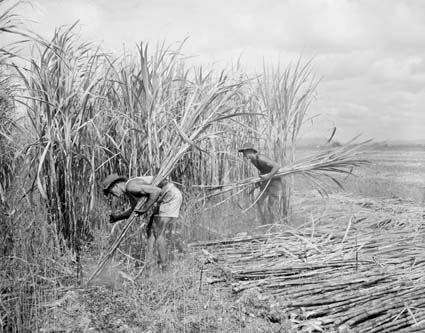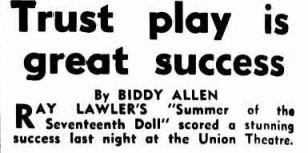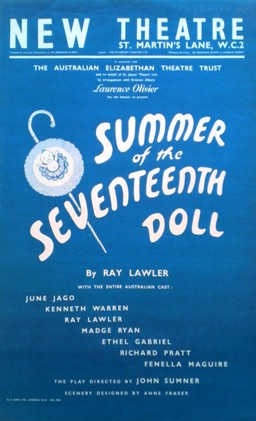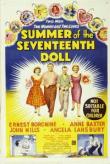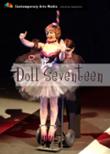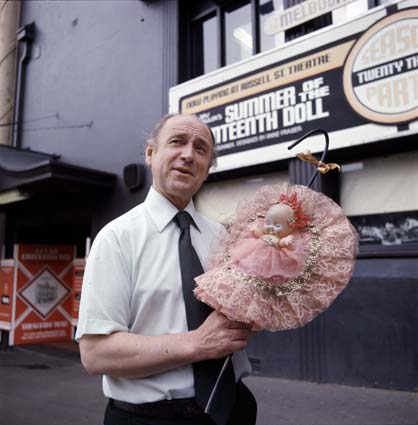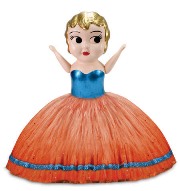AustLit
-
This trail collects a range of items to enhance readers' engagement with Summer of the Seventeenth Doll.
– Part One provides an overview of Summer of the Seventeenth Doll, its author Ray Lawler, and the play's genesis and early productions.
– Part Two highlights Lawler's creation of The Doll Trilogy and the adaptation of Summer of the Seventeenth Doll to radio drama, cinema, opera and theatrical fantasy.
– Part Three focuses on the structure and language of Summer of the Seventeenth Doll and its major themes including bush/urban and masculine/feminine binaries.
– Part Four looks at Summer of the Seventeenth Doll's place in Australian theatre history.
– Part Five offers suggestions for wider reading.
– Part Six provides tips for further research.
Click on the hyperlinks below to visit AustLit records and external references. Some of the critical works and other resources are available online.
-
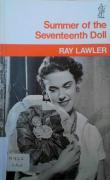 Image taken from NLA copy.See full AustLit entry
Image taken from NLA copy.See full AustLit entry'The most famous Australian play and one of the best loved, Summer of the Seventeenth Doll is a tragicomic story of Roo and Barney, two Queensland sugar-cane cutters who go to Melbourne every year during the 'layoff' to live it up with their barmaid girl friends. The title refers to kewpie dolls, tawdry fairground souvenirs, that they brings as gifts and come, in some readings of the play, to represent adolescent dreams in which the characters seem to be permanently trapped.
(...more) -
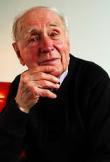 This image has been sourced from AustralianPlays.org. Photo credit: Sam MooySee full AustLit entry
This image has been sourced from AustralianPlays.org. Photo credit: Sam MooySee full AustLit entryRay Lawler left school at thirteen to work in a foundry. He developed an interest in amateur dramatics and play-writing in his twenties. He wrote a number of plays before attracting attention when Cradle of Thunder was produced in 1949 and won the National Theatre Movement's Jubilee play competition. But it is Summer of the Seventeenth Doll (1955) for which Lawler is most admired. Lawler's radical exploration of themes such as mateship and myth in Australian culture influenced writers in many genres.
-
Genesis
Ray Lawler wrote Summer of the Seventeenth Doll in the Melbourne Public Library (now the State Library of Victoria (Strauss, Dagmar. ‘Ray Lawler.’ Facing Writers: Australia's Leading Writers Talk with Dagmar Strauss 1990: 104). At the time of writing, he had just returned to Melbourne after working at the Cremorne Theatre in Brisbane. While at the theatre, he noticed two canecutters, wooing chorus girls, and was struck by their ‘magnificent self-confident masculinity’ (qtd. in Brisbane, Katharine. ‘Growing Up in Australia.’ Summer of the Seventeenth Doll 1978: xxvi).
Lawler was also struck by the comparison between the 'wild and raunchy lifestyle' that had developed in Brisbane during the war years and the 'very staid and buttoned up' nature of Melbourne. 'I felt a stirring, a sense of opposites – the North as an invading life force, perhaps – raw and vigorous and living for the day, coming into mating conflict with a South of cooler values and considered expectations?' ('The Doll Revisited: A Truer Realisation.' Summer of the Seventeenth Doll 2012: vii-viii).
-
Summer of the Seventeenth Doll, which rapidly became known as simply The Doll, was joint winner (with Oriel Gray's The Torrents) of the 1955 Playwrights' Advisory Board prize. The play premiered at the Union Theatre, University of Melbourne, on 28 November 1955 and was then produced at the Elizabeth Theatre, Sydney, from 11 January 1956. After touring cities and regional towns in Australia, the Union Theatre Repertory Company began a UK tour culminating in a seven-month season at London's New Theatre. (In the Melbourne, Sydney and UK seasons, the role of Barney was played by Ray Lawler.) The Doll won the London Evening Standard Best Play of the Year for 1957. A less successful US tour followed with The Doll playing on Broadway for just five weeks.
A number of early Australian reviews of The Doll are available online via Trove Australia's digitised newspapers. To read more about the UK and US tours see:
- Grant, Bruce 'English Critics and The Doll.' Meanjin 16.3 (1957): 295-298
- Sumner, John. 'The Doll in London.' Australian Theatre Year Book. F. W. Cheshire: Melbourne, 1958: 18-20
- Langner, Lawrence. 'Up from Down Under.' Playbill 4.2 (27 January 1958): 9, 32
- 'The Play in the Theatre.' Summer of the Seventeenth Doll. Currency Press: Paddington, 1978: xx-xxxx.
and
- Rees, Leslie. 'Appendix II: The Intimate Life of The Doll.' The Making of Australian Drama: From the 1830s to the Late 1960s. Sydney: Angus and Robertson, 1973: 410-420. (Rees includes detailed coverage of audience and critical responses to the play’s productions in Melbourne (1955), Sydney (1956) and London (1957), as well as in New York and, to a lesser extent, Germany (both 1958).)
For later performances of The Doll, visit the Ausstage website. The site, which is regularly updated, lists over 120 performances of Lawler's play in capital cities and regional centres around Australia as well productions in New Zealand, the US and the UK. Click here to view.
-
The Doll a 'Stunning Success' - Melbourne
On the morning after the Doll's premiere, the Melburne Argus's Biddy Allen wrote: 'Ray Lawler's Summer of the Seventeenth Doll scored a stunning success last night at the Union Theatre ... [Lawler] has written a play so superbly true to Australian thought and the Australian theme, that theatrical conventions disappear ... "Barney," "Roo," "Pearl," and "Emma" are real people. We know their faces, their voices – we share their dreams, we understand their failures.'
Source: Allen, Biddy. 'Trust Play Is Great Success.' The Argus (29 November 1955): 6.
-
The Doll in London
'I was standing with John Sumner outside the New Theatre, St. Martin's Lane, London, leaning backwards to hear what the issuing audience was saying about The Summer of the Seventeenth Doll ... Did all theatre audiences look like this when they came out into the world again – shiny-eyed, chattering, happy with each other? I had watched cinema audiences blinking in the sunshine or loping into the night and I had never seen this gaiety. Sumner, still swaying for information, was trying hard not to smile outright, perhaps to burst into song. It must be very good. I caught some words ... "Jolly good show" ... "Extraordinarily interesting" ... and, more reassuring ... "Like a breath of fresh air." Sumner, satisfied, waved me over. "It's a hit," he said, "let's have a coffee." As we turned the comer, we stopped to look at the faces of Lawler, Jago, Ryan, Warren framed intensely against the wall. "It's true!" he said, "it's really on!"'
Source: Grant, Bruce. 'English Critics and The Doll.' Meanjin 16.3 (Spring 1957): 295.
Above: Advertising poster for the Sir Laurence Olivier and Elizabethan Theatre Trust production of The Doll, New Theatre, St. Martin's Lane, London, 1957.
-
This essay, an introduction to Summer of the Seventeenth Doll, was written for the Reading Australia project. McGirr characterises the play's setting as 'Miss Haversham's wedding cake in a Carlton terrace. Hope promised and now gathering dust'. McGirr backgrounds the Doll's main characters and themes, and provides an account of his own experiences of directing and acting in the play.
Available online at Reading Australia.
-
Ray Lawler lived in Europe for over a decade after the New York run of Summer of the Seventeenth Doll. At first in Denmark and then later in Ireland, he began the process of revising The Doll and of writing its two prequels – Kid Stakes, set in 1937 and Other Times, set in 1945. Lawler returned to Australia in the early 1970s and his trilogy was performed in its entirety at the Russell Street Theatre, Melbourne, on 12 February 1977.
For further background on the writing and staging of the trilogy, see:
- Lawler, Ray. ‘The Doll Revisited: A Truer Realisation.’ Summer of the Seventeenth Doll. Strawberry Hills: Currency Press, 2012: vii-xii
- Brisbane, Katharine. ‘Growing Up in Australia.’ Summer of the Seventeenth Doll. Paddington: Currency Press, 1978: ix-xxii
and
- Sumner, John. ‘The Plays on the Stage.’ The Doll Trilogy. Sydney: Currency Press, 1978: xiii-xx.
For a critical assessment of the effects on The Doll of Lawler's revisions, see:
- Hooton, Joy, W. 'Lawler's Demythologizing of the Doll: Kid Stakes and Other Times.' Australian Literary Studies 12.3 (May 1986): 335-346.
-
- The first adaptation of Summer of the Seventeenth Doll was prepared by Joy Hollyer for ABC Radio. A copy of the typescript for this radio play is held in the Hanger Collection of Australian Playscripts, Fryer Library, University of Queensland. While no Australian broadcasts of this play have yet been traced, Hollyer’s adaptation was aired in the UK on 10 August 1970 on BBC Radio 4. The production featured June Salter in the role of Olive.
- A 1959 film adaptation of The Doll, starring Ernest Borgnine (Roo), Anne Baxter (Olive), John Mills (Barney) and Angela Lansbury (Pearl) was released under the title Season of Passion. The American-made film changed the play’s setting from Melbourne to Sydney and altered the ending. In a newspaper interview in 2011, Lawler confessed he had ‘never had any desire to see’ the movie. 'They offered me the chance to work on the script', Lawler told Steve Meacham, 'but they said they weren't interested in Australian content. I told them "Well, the only thing I've got is Australian content" ('Lucky Play.' Sydney Morning Herald 3 September 2011).
- In the mid-1990s composer Richard Mills and librettist Peter Goldsworthy created an opera adaptation of The Doll. The two-act chamber opera was commissioned by the Victorian State Opera and produced at the Playhouse, Victorian Arts Centre, in October 1996. In preparation for her article 'The Making of the Doll', Rachel Buchanan spent time in the opera’s rehearsal space. Buchanan talks with Mills and Goldsworthy about the challenges of adapting The Doll, and provides a word-picture of the opera’s sets, costumes, workshops and production meetings. (The Age. Saturday Extra. 18 October 1996: 1.)
- Nearly 50 after writing Summer of the Seventeenth Doll, Ray Lawler gave his permission for Jacqui Carroll to reconfigure The Doll as theatrical fantasy. Doll Seventeen, 'a blend of dance and traditional Japanese theatre', replaces most of Lawler’s dialogue with movement and music. Carroll’s 'designed impression' of The Doll was performed at the Brisbane Powerhouse, 18-25 September 2002. See the Frank Theatre website for the director’s notes and some reviews of this production.
-
Radio, Cinema, Opera and Theatrical Fantasy Adaptations
-
'Summer of the Seventeenth Doll ... combined the familiar form of the realist three-act play with the shock of seeing and hearing, probably for the first time in a major theatre, the colours and the sounds of modern Australian life.' (Brisbane, Katharine. 'Theatre from 1950'. The Cambridge History of Australian Literature. Cambridge: Cambridge University Press, 2009: 392-393.)
-
Elizabeth Webby, in 'Summer of the Seventeenth Doll' (in Modern Australian Plays (1990): 14-23), reflects that Lawler, 'working with the constraints of theatrical naturalism ... is still able to draw on a wide range of dramatic resources, including some dating back the popular theatre of the nineteenth century' (15). Webby’s article concentrates on The Doll's 'visual qualities, including the significance of sets and costumes, and the use of stage pictures, or tableaux, at the end of scenes' (15). She concludes that Lawler's play 'is a marvellous piece of stagecraft, with Lawler employing to the full the physical and visual resources of theatre' (23).
In his review of the 2012 Melbourne Theatre Company production of Summer of the Seventeenth Doll (''This Harsh, Cawing, Strongly Felt Play'.' ABR 339 (March 2012): 21-22), John Rickard also notes the ‘old-fashioned’ form of The Doll's construction. He comments, too, on the play's 'masterly transition from broad comedy to searing drama'. A contemporary playwright, says Rickard, 'might have been tempted to use flashbacks and a more cinematic exposition, but in Lawler's play the past is nevertheless powerfully present, particularly in the memories of Nancy...' (21).
For additional information on the structure of The Doll, see Dennis Carroll's 'Ray Lawler, Richard Beynon, Alan Seymour.' Australian Contemporary Drama. rev. ed. Paddington: Currency Press, 1994:103-124.
-
MTC Production, 2012
Scenes from the technical rehearsal of the 2012 Melbourne Theatre Company (MTC) production of Summer of the Seventeenth Doll, directed by Neil Armfield.
(See also a video clip from the ABC's 7.30 Report about the 2011 Belvoir Street Theatre production, also directed by Armfield. Click here to view.)
https://www.youtube.com/embed/NOdbURko_yY -
May-Brit Akerholt, in her article 'Summer of the Seventeenth Doll' (in Storyline 17 (2007): 28-30), argues that the ‘impact The Doll had on its first audiences was 'partly due to the fact that they were listening to the actors using their own language, not the British-accent stage language actors were trained to speak and audiences were used to hearing. Here was a play in which actors spoke the vernacular in their real voices' (28). Akerholt suggests that Lawler created a 'stage language' that explored 'the Australian convention of using irony and vivid jargon to replace communication and emotions. From beneath a surface of a laconic and dry, yet colourful vernacular emerges an imaginative and poetic dramatic dialogue. The unexplored possibilities of language, and the perils of ignoring them, become virtually another "character" in The Doll' (30).
Other writers who comment on Lawler’s use of the Australian vernacular include:
- Hecq, Dominique. 'This Classic Australian Play: The Doll.' Commonwealth 20.2 (1998): 79-86. (Hecq notes particularly the ways in which the 'linguistic limitations' of the characters enhance the '"realism"' of the play’.)
- Fitzpatrick, Peter. 'Ray Lawler.' After 'The Doll': Australian Drama Since 1955 (1979): 19-33. (Fitzpatrick argues that the 'Australian-ness of Lawler's speakers is more a matter of syntax than vocabulary' (31).)
and
- Lawler, Ray. 'Summer of the Seventeenth Doll and the Modern Audience.' Meanjin blog. (2012). (Lawler observes that Australian language and ‘the rhythm of Australian vernacular’ have changed since he first wrote the play.)
-
Katharine Brisbane, in her introduction to the 1978 Currency Press edition of Summer of the Seventeenth Doll ('Growing Up in Australia', pp. ix-xxii) says the play is about growing up. 'It is about growing up and growing old and failing to grow up'; it 'could only have been written when it was: in the 1950s'. Brisbane highlights developments taking place in Australia in the mid-20th century: 'It was a time of post-war reconstruction and immigration, of materialism, a wool boom, of suburban comfort and conservatism – the first decade since early in the century in which the ordinary Australian had not been hounded by war, depression and drought' (ix).
Given this period of cultural and economic dynamism, T. G. A. Nelson (in 'Summer of the Seventeenth Doll and Summer of the Aliens: Arcadia, Dystopia and the Australian Ethos.' Unemployed at Last!: Essays on Australian Literature to 2002 for Julian Croft (2002): 105-118) underscores what he sees as the absences in The Doll: World War II (the title, says Nelson, 'invites audiences to imagine an unbroken series of sixteen lay-off seasons' (107)), 'the tension between established white Australians migrants' (108), anti-British feeling (109), 'class hatreds and rivalries' (109), 'sex and its consequences' (111) and 'politics, class divisions and religion' (111). Nelson’s contention is that while The Doll has 'some realistic elements ... it is not in any way a documentary or a comprehensive look at Australian life in the 1950s' (112).
-
The Doll's 'action, plot and characterisation brought the bush legend kicking and screaming into the city, almost literally' (78) – this John McCallum’s assessment (in 'Into the City.' Belonging: Australian Playwriting in the 20th Century (2009): 77-90) of Lawler’s play. In another article in Belonging (p.51-76), McCallum asserts that The Doll can be viewed as 'a testosterone-driven version of the traditional station drama' (53). McCallum points out, however (in 'Into the City'), that the 'canecutters and barmaids were as exotic for Australian middle-class theatregoers and journalists as were the characters in the plays of J. M. Synge and Tennessee Williams, the overseas comparisons that were instantly made' (80).
In 'What's Bugging Olive?: A New Reading of the "Doll".' (Southerly 50.2 (June 1990): 170-181), Imre Salusinszky suggests that the 'bush myth' in Lawler’s play operates as a fertility rite: 'the bush myth is about the wish of the central characters to align human life – in particular the sexual side of human life – with the natural cycle of the seasons, rather than with the artificial cycle of the working day: the nine-to-five cycle of industrial capitalism ... The lay-off is, in a real sense, a fertility ritual.'
-
A number of commentators have written about Lawler’s portrayal of men, of women, and of relationships between the genders in Summer of the Seventeenth Doll. Here is a sampling of those articles:
- Pratt, Catherine. 'Playing with Dolls: Masculinity and Desire in Summer of the Seventeenth Doll.' Crossing Lines: Formations of Australian Culture (1996): 84-88.
Pratt argues that the determining factor that shapes The Doll 'is the compulsion to define and fix masculinity, femininity and heterosexuality' (84). She investigates ‘the relationship between, on the one hand, the play’s heterosexual dynamics and its construction of female sexuality, and on the other, the submerged central drama of the men’s desire for each other’ (84), suggesting that the 'off-stage' relationship between Roo and Barney 'shapes and controls the surface drama' of the Melbourne lay-off (87).
- Bollen, Jonathan, Bruce Parr and Adrian Kiernander. 'Fists, Boots and Blues.' Men at Play: Masculinities in Australian Theatre Since the 1950s. Amsterdam: Rodopi (2008): 32-51.
The authors examine the role of physical violence in Australian plays as a means of conveying emotion in male characters. They point out that 'one of the recognised traits' of the male Australian character was 'inarticulacy' (37) and that physical violence allowed an avenue for expressing emotion without resort to language. 'Realistic enactments of masculine violence at moments of dramatic climax generated theatrical experiences that were socially compelling, distinctly masculine, and appropriately Australian. It was, in effect, a solution to the problems of staging "the masculinity of Australian life"' (42).
- Cousins, Jane. 'Gender and Genre: The Summer of the Seventeenth Doll.' Continuum: Journal of Media and Cultural Studies 1.1 1987.
Cousins was among the first to approach The Doll from a feminist perspective. She argues that The Doll’s attempt 'to transcend the stereotype of the "outback hero" and to construct a new, unified (and ultimately masculine) Australian identity founders on the sexual division of narrative labour' and that its 'particular textual construction of "woman" as mirror of male identity does not necessarily serve the historically specific interests of masculine self-representation.'
- Goldsworthy, Kerryn. 'Is It a Boy or a Girl? Gendering the Seventeenth Doll.' Southerly 55.1 (1995): 89-105.
Goldsworthy, like Cousins, views The Doll through the lens of feminist theory. She offers 'some arguments that are quite deliberately both perverse and partial ... they include the identification of Barney as an unwitting radical feminist; the suggestion that the (91) kewpie dolls are not entirely girls; the reading of the stage set as a metaphor for a passive and penetrable female interior; and the suggestion that Olive refuses to marry Roo ... because she regards husbands as emasculated creatures ... [and] marriage to Roo would amount to a form of suicide' (91-92).
- McCallum, John. 'The Doll and the Legend.' Australasian Drama Studies 3.2 (April 1985): 33-44.
McCallum argues that Lawler 'has presented us with some of the most lively and perceptive female characters in our drama ... And he has presented us with male characters ... who to modern [1980s] taste come across all too often as pompous bores, with their sentimental dreams, their weakness and their pride. The women are often strong, energetic and capable of great insight into their condition, but they suffer from a fatal dependency which allows the weak men to control that condition.'
To read articles discussing the theme of marriage in The Doll, see Dagmar Strauss's interview with Ray Lawler in Facing Writers: Australia's Leading Writers Talk with Dagmar Strauss (1990): 103-113; for more about the theme of mateship, see T. Inglis Moore's 'The Meaning of Mateship' in Meanjin Quarterly 24.1 (March 1965): 45-54.
-
Ray Lawler with a Kewpie Doll
Ray Lawler holds a kewpie doll in front of the Russell Street Theatre, Melbourne, 1977.
In his original set description for Summer of the Seventeenth Doll, Lawler describes the 'main decorative features' in the front room: 'souvenirs brought down by Roo on past visits ... the most notable of these are sixteen kewpie dolls, wearing tinsel headdresses and elaborately fuzzy skirts, attached to think black canes shaped like walking-sticks'.
The 2012 Currency Press edition of The Doll includes an introductory note by Lawler. In the note, Lawler explains some elements of the play that may not be familiar to 21st century theatre goers. He explains that kewpie dolls are 'no longer a popular carnival novelty' and that the 'modern version, when seen, usually features a smallish doll of no particular style, with a wisp of coloured net for skirt, and meagre feather or two for decoration. These are a far cry from the glittering prize specimens of the 1930s, '40s and '50s' (xii).
-
'Much of The Doll’s success was in the timing.' (McCallum, John. 'Into the City.' Belonging: Australian Playwriting in the 20th Century. Strawberry Hills: Currency Press, 2009: 78.)
-
Writing shortly after Summer of the Seventeenth Doll’s premiere season, theatre director and critic Wal Cherry observed that, until that point in Australia’s theatre history, local dramatists had relied on 'amateur or semi-professional groups for the productions of their plays' or had 'tried to write for a theatre which did not exist'. In early 1956, Cherry 'sniffs the air and scents a change' ('Summer of the Seventeenth Doll.' Meanjin 15.1 (1956):82).
One of the ‘scents of change’ was the establishment of the Australian Elizabethan Theatre Trust. The Trust’s financial support enabled the Melbourne production of The Doll. As John McCallum puts it in his critical article 'Into the City' (in Belonging: Australian Playwriting in the 20th Century), The Doll was 'the first professionally-produced Australian play outside the commercial theatre to receive any serious professional support and backing' (78).
For further insights into the timing of The Doll’s arrival on the Australian theatre scene, see:
- Fitzpatrick, Peter. 'Births, Deaths and Renaissances.' and 'Ray Lawler.' After 'The Doll': Australian Drama Since 1955 Melbourne: Edward Arnold, 1979: 1-18, 19-33
and
- Brisbane, Katharine.. 'Theatre from 1950.' The Cambridge History of Australian Literature, Cambridge: Cambridge University Press, 2009: 391-418.
In the years immediately following The Doll's early productions, other Australian plays achieved success with local audiences. These include Richard Beynon's The Shifting Heart (1957), Peter Kenna's The Slaughter of St. Teresa's Day and Alan Seymour's The One Day of the Year (1960).
To discover more about the cohort of plays written and produced in the late 1950s and early 1960s, see:
- Kippax, H. G. 'Australian Drama Since Summer of the Seventeenth Doll.' Meanjin Quarterly 23.1 (1964): 229-242
- Davison, Peter H. 'Three Australian Plays: National Myths Under Criticism.' Southerly 23.2 (1963): 110-127
and
- Sturm, Terry. 'Drama.' The Oxford History of Australian Literature Melbourne: Oxford University Press, 1981: 173-267.
-
Geoffrey Milne, in 'Lining up the Canon' (Storyline 17 (Summer 2007): 4-9), uses M. H. Abrams definition of the 'canonical' to propose a canon of Australian drama. Milne begins his list with Summer of the Seventeenth Doll saying there is 'no doubt' it 'deserves its place as the breakthrough play of its era' (6).
While recognising the contributions of works such as Leslie Rees's The Making of Australian Drama: A Historical and Critical Survey from the 1830s to the 1970s, Peter Holloway's Contemporary Australian Drama: Perspectives Since 1955 and Dennis Carroll's Australian Contemporary Drama in shaping a canon of Australian drama, Milne argues that more needs to be done to extend the coverage of those publications into the later 20th and early 21 centuries and to include plays by women and Indigenous playwrights. He cites The Dolls' Revolution: Australian Theatre and Cultural Imagination (2005) as a work that redresses previous omissions and brings the canon into the 21st century.
-
- Summer of the Seventeenth Doll was one of eight 'landmark plays' selected by the ABC to feature in the Playing the 20th Century, a series that charted a century of Australian theatre. A production of the Doll, together with archival interviews with Ray Lawler, historian Michelle Arrow, theatre critics John McCallum and Katharine Brisbane, and theatre director Ralph Myers can be heard here.
- Playwright, author and former Justice of the High Court of Australia Ian Callinan, in 'Reflections on a Revival of the Doll', ABR 306 (November 2008): 43-45, contextualises the 2008 La Boite production of The Doll by providing an insight into the Queensland sugar industry and the lives of the canecutters in the latter decades of the 20th century.
-
'Betty', the Kewpie Doll
Giant kewpie dolls were integral to the closing ceremony of the Sydney 2000 Olympic Games.The image below is 'Betty', one of the twelves dolls that 'twirled their way around Stadium Australia during the closing ceremony ... When Betty entered the arena, the party was reaching its climax. John Paul Young sang "Love Is in the Air" as 960 couples danced the samba in unison, accompanied by 200 giant jiving feet on sticks. The designers of the segment drew their inspiration from the sideshow, Strictly Ballroom and Summer of the Seventeenth Doll.'
Source: Sear, Martha. 'Kewpie Doll: A Very Big Doll.' National Museum of Australia 2012.
-
- There is additional information in AustLit about Ray Lawler and Summer of the Seventeenth Doll – follow the links within Ray Lawler's author record and the record for Summer of the Seventeenth Doll to explore more.
- To further investigate topics such as the literary portrayal of men and of women in Australian literature, go to the AustLit search page and explore the Advanced Search options. For help on building searches, visit the 'How to Search AustLit' page.
Many online resources deal with Summer of the Seventeenth Doll. These can be easily discovered through a browser search. Resources include:
- 'Summer of the Seventeenth Doll: Teacher’s Notes.' (Notes produced by Belvoir Street Theatre to coincide with the theatre company’s 2011 production of The Doll.)
- 'Summer of the Seventeenth Doll: Course Notes.' (Prepared by Tracy Sanders, Australian Catholic University.)
- 'Summer of the Seventeenth Doll.' (In this History of Australian Theatre Archive article, Leann Richards focuses on the audience and critical reception of the first Melbourne, Sydney and London productions.)
- The trailer for Catherine Gough-Brady’s documentary What I Wrote: Ray Lawler. (In the documentary, Lawler talks with writer and teacher Tess Brady, explaining 'the back story behind Barney, Roo and Olive' and 'placing these characters in their historical setting'. Lawler also discusses the 'writing and re-writing process' that generated The Doll Trilogy.)
and
- 'Cue the Chorus: An Ever-Changing Idiom: A Response to Summer of the Seventeenth Doll by Ray Lawler'. (Playwright Alana Valentine’s response to The Doll.)
You might be interested in...



